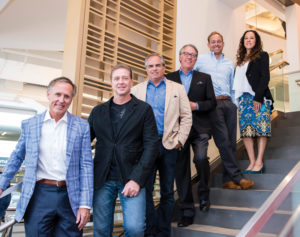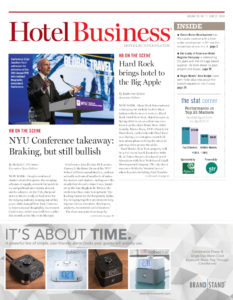
left to right: Bob Olson, R.D. Olson Construction; Jay Pecotte, Hard Rock International; Todd Wynne-Parry, Commune Hotels & Resorts; Rick Riess, Montage Laguna Beach; Daniel Hyde, Pacifica Hotels; and Lorraine Francis, Gensler
NEWPORT BEACH, CA—Sister publication Hotel Business Design and Gensler late last month hosted a Hospitality Talk event focused on mega-trends in the industry: technology, Millennials and the sharing economy. Sponsored by Evolve, Global Allies, Littman Brands Contract, Grohe and Daltile, the session was moderated by Nicole Carlino, senior associate editor.
Panelists included Daniel Hyde, VP of design, development and construction, Pacifica Hotels; Rick Riess, managing director at Montage Laguna Beach; Jay Pecotte, senior director project development, hotels & casinos – Americas, Hard Rock International; Lorraine Francis, regional director of hospitality interiors, Gensler; Todd Wynne-Parry, EVP, acquisitions & development, Commune Hotels & Resorts; and Bob Olson, CEO, R.D. Olson Construction.
While technology is increasingly important to guests, the panelists agreed that, in practice, caution is usually necessary before implementing new solutions. “We have guests who can’t figure out how to turn the TV on,” said Riess. “We look at technology more in terms of managing guest data and preferences; it’s more behind the scenes.” Wynne-Parry noted, “If there is technology in the room, the guest shouldn’t see it.” He likened it to a faucet where the water just seamlessly flows.
However, planning is also key. “We’ve been installing [keyless entry]hardware for three to four years now, waiting for it to come,” said Olson. “You have to anticipate—where is this going?” While Hyde noted that many tech solutions could be more complicated than the average guest wants, the solutions that are coming out today “inspire us.” He also noted that, from an operational standpoint, automation makes sense. “Especially being based in California, where we have minimum wage going up, we’re looking at stuff like this, too—how do you make it work? We study it, but we’re still always in the mindset of ‘Can the oldest of our guests understand it?’”
Millennials is another subject the panelists tackled. “Millennials want designer water, really good coffee and to experience the community,” said Wynne-Parry. “We deal with what they’re expecting—design, flawless technology, some giveback to the community and that the food is awesome.”
“What Millennials want—that’s what I want too,” pointed out Olson. “That’s the thing—they’re focused on an age group when they should be focused on Millennial-minded, right?” said Pecotte.
“It’s less demographics and more psychographics,” said Francis. “Design-wise, where we’re seeing it is where we can capture those Instagrammable moments in our design that become an opportunity to get some PR and press.”
While the trends are something every guest wants, Wynne-Parry did credit Millennials with driving the change. “It’s a pain, but they demand and expect [better],” he said, likening the generation to kids who call fouls during a soccer game. “They are guiding us.”
The panelists also discussed the sharing economy. Hyde noted that guests are looking for something authentic, which is a main driver of the sharing economy (along with price and the desire for a kitchen). “We focus on the experiences people are getting that are different from us, because [Airbnb] will always win on location,” he said. But, he noted, the sharing economy has kinks to work out: “They don’t have real security and service, and they have a self-censorship in ratings.”
Pecotte pointed out that the sharing economy affects the segments differently. “For us, it’s on the radar, but it doesn’t worry us much because our guests want a more immersive experience,” he said.
Francis also noted the rise of the design-oriented hostel could be a compromise point. “Freehand Chicago is a great example—there are four beds to a room at $25 a pop, so you’re still getting the ADR, and then you have great F&B,” she said, highlighting that the leisure guest gets the inexpensive price while the hotel gets the usual rate. “Then you also have a mix of 35% private rooms, so business travelers will still go there for the sense of community.”
For more of the discussion, check out the July/August issue of Hotel Business Design. HB

